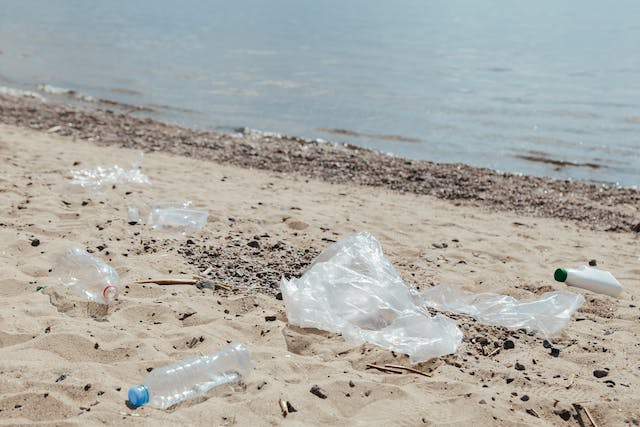
Why is there a plastic island in the Pacific Ocean? Because of the amount of plastic waste we throw into the sea and because of the point where ocean currents converge.
There are plastic islands in all of the oceans on Earth, not just the Pacific. The Great Pacific Garbage Patch just happens to be the largest of them all. It was first discovered in 1997 and it has been growing ever since. The garbage patch is divided into two halves. The eastern garbage patch is near Hawaii and California. The western garbage patch is near Japan. The patches are currently about 3 times the size of France. The size of France is not changing, though, and the Great Pacific Garbage Patch is getting larger year by year. It was discovered in 1997 when Charles Moore, an oceanographer, was sailing across the Pacific and came across it. He noted a sea of plastic so wide that it took him seven days to get through it.
So, why is there so much plastic? Some of the plastic comes from ships, but a lot of it washes out from the land. It is estimated that 46% of the Great Pacific Garbage Patch is made up of fishing nets. The location of the plastic island is obviously an indicator of where the land plastic originates from. The plastic in the Pacific plastic island comes from Asia, the US, and South America. The Atlantic patch comes from the US, Europe and northern Africa. Most of the fishing gear waste in the Great Pacific Garbage Patch has been dumped by China, Japan, Taiwan, and the US.
Plastic is a polymer and it will not biodegrade. When things die, they are broken up by microbes into their component chemicals and reabsorbed into the earth. Plastic polymers are not recognized by any enzymes that break down other material, and thus they don’t biodegrade. However, they are broken down by the sun and by erosion. UV light can break up the plastic into smaller molecules, but these smaller molecules cannot be broken down any more and they remain as microplastics. Erosion can also leave microplastics because all of the plastic trash in the ocean is constantly rubbed by other pieces and broken down. All of this means the Great Pacific Garbage Patch is mostly a soup of microplastics.
So, why has all this trash and the microplastics gathered in the middle of the Pacific Ocean? It is because of the ocean currents. There are four currents that travel clockwise through the North Pacific Ocean. The North Pacific Current crosses the Pacific from Japan to the west coast of the USA. The Californian current goes along the west coast of the USA, down as far as Mexico. The North Equatorial Current goes across the Pacific from Mexico to roughly Papua New Guinea. The Kuroshio Current goes from Papua New Guinea, up the east coast of Asia and past Japan. These four currents are driven by the winds and they are vital for the transfer of heat, nutrients, and oxygen around the Pacific Ocean. Without them, life would probably not exist. They are also the reason why the Great Pacific Garbage Patch is where it is.
The four currents connect to each other and form a clockwise route around the North Pacific. Anything that enters one of the currents can very easily be carried around all four of them. In the center of the four currents is an area called a gyre. In this case, the North Pacific Subtropical Gyre. A gyre is a vortex and there are five major gyres in the world: in the North and South Pacific, in the North and South Atlantic, and in the Indian Ocean. There is a plastic island in every one of these gyres. The currents carry plastic trash from wherever it enters the ocean and it goes round all four currents, slowly moving closer to the center. At some point, it slips out of the current and enters the gyre. The gyre in the North Pacific rotates in the clockwise direction of the four currents, but it is very calm and smooth. Plastic slowly moves towards and the center of it and, like a black hole, once it has entered the gyre it cannot escape. We are feeding plastic into these currents, so the plastic islands in the gyres are only going to grow larger.
I say that the plastic cannot get out, but it does have one direction it can do in. Plastic generally floats, but, surprisingly, researchers have found that 70% of the plastic from the plastic islands has actually sunk to the bottom of the sea. And this is what I learned today.
Photo by Ron Lach : https://www.pexels.com/photo/clear-plastic-bottle-on-white-sand-near-body-of-water-9034661/
Sources
https://oceantracks.org/library/the-north-pacific-ocean/major-currents
https://www.iberdrola.com/sustainability/5-garbage-patches-in-the-ocean
https://www.iberdrola.com/sustainability/plastic-island-in-pacific-eighth-continent
https://science.howstuffworks.com/environmental/earth/oceanography/great-pacific-garbage-patch.htm
https://education.nationalgeographic.org/resource/great-pacific-garbage-patch/
https://en.wikipedia.org/wiki/North_Pacific_Gyre
https://news.osu.edu/why-isnt-plastic-biodegradable/
https://ourworldindata.org/plastic-great-pacific-garbage
https://oceanexplorer.noaa.gov/facts/currents.html
https://oceanservice.noaa.gov/facts/gyre.html
